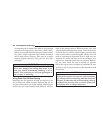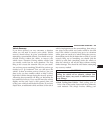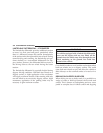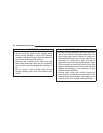
vehicle from DRIVE to REVERSE, while applying
throttle after each shift. During this process, for addi-
tional traction, try turning your steering wheel quickly
back and forth no more than a
1
⁄
4
turn. If you are stuck
in mud, sand, or snow try spinning your tires during
this process to clean the debris from the tread and
improve the traction. You want to create a rocking
motion with the vehicle. This helps build vehicle
momentum, which hopefully gets you out. Remember
to ease off and on the accelerator before and after the
shift. If after a few rock cycles your vehicle is not free,
stop and try another method of recovery. Continuous
rock cycling will only cause unnecessary damage to
your vehicle and the environment.
CAUTION!
Damage can occur when spinning your tires at an
excessive high speed. Do not spin your tires faster
than an indicated 35 mph (56 km/h).
•
Using the Tow Hooks With a Tow Strap – Tow straps
are a quick and easy way to recover your vehicle from
minor situations if you have a secondary vehicle
which is not stuck. The tow hooks on your vehicle are
designed to take the abusive force generated during
vehicle recovery. Do not use the bumper or any other
vehicle component as an attachment point. Using tow
straps requires coordination between the two drivers.
Good communication and line of sight are required for
a safe recovery. First connect the tow strap to the
correct attachment points on both vehicles. There
should be a least 20 to 30 feet between the vehicles to
allow for a safe recovery. If necessary join two tow
300 STARTING AND OPERATING


















